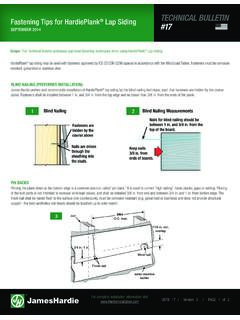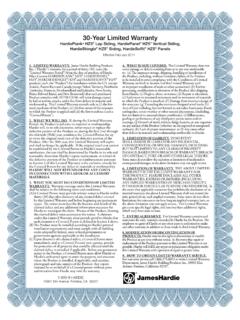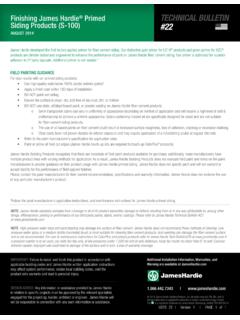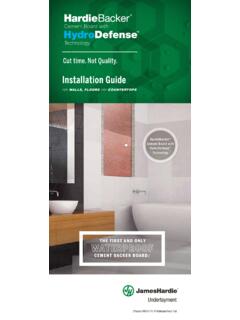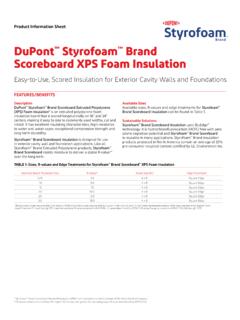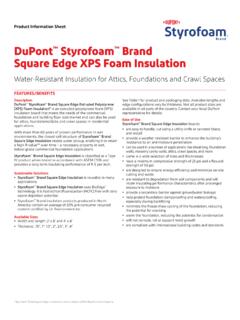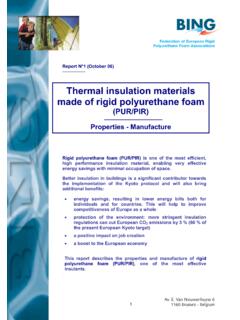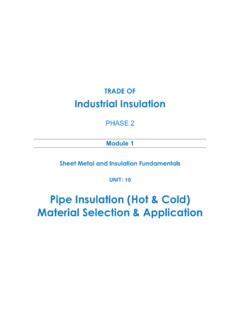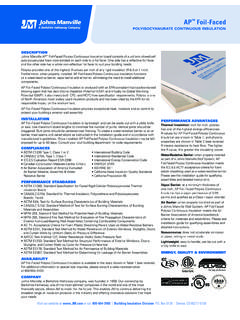Transcription of SCOPE - James Hardie
1 Applying James Hardie Siding over Continuous TECHNICAL BULLETIN. insulation and Non-Nailable Substrates #19. SEPTEMBER 2014. The guidance and instructions provided in this technical bulletin are valid for and applicable to James Hardie products only. James Hardie Building Products Inc. makes no warranty or representation with respect to use of the information contained herein for any use other than with James Hardie products, including but not limited to use with fiber cement siding products made by others or siding products made of other materials. You bear all risk associated with using any of the information contained herein in any way other than with James Hardie products, including in the design or construction of structures with fiber cement siding products made by others or siding products made from other materials.
2 Rainscreen application for panels - James Hardie requires a 3/8 in. air gap (Rainscreens, Furring, Etc.), when installing HardiePanel on a Multi-Family/. Commercial project. Reference Rainscreen guidelines here: SCOPE . This bulletin summarizes the application of Hardie Siding by two methods that align with the goal to improve the building's thermal envelope: Method 1 - James Hardie Siding installed directly over continuous insulation ( ) and other non-nailable substrates ( gypsum sheathing) with combined thickness of 1 inch or less Method 2 - James Hardie Siding installed to furring strips that are attached through the and other non-nailable substrates ( gypsum sheathing) and to wall framing Building codes are evolving and require improved building energy efficiency.
3 The Department of Energy (DOE) is working from the code development goals below; these goals directly relate to the building's thermal envelope requirements. US Code development goal is 30% energy efficiency improvement in 2012 IECC (relative to 2006)1. US Code development goal is 50% energy efficiency improvement in 2015 IECC (relative to 2006)1. National Energy Code for Housing, in Canada, is to have approximately 25% more efficiency and is to be included as an update to the NBC Part 9 in late CONTENT. Method 1, Applying Hardie Siding Directly through Non-Nailable Substrates 1 inches thick and less Page 2.
4 Method 2, Applying Hardie Siding to Furring Installed Over Non-Nailable Substrates up to 4 inches thick Page 4. DISCLAIMER Page 6. Appendix A Reference Material Page 7. Table 1, James Hardie Product Installation Literature Page 7. Table 2, Siding Weight Page 7. Table 3, Softwood Furring Weight Page 7. Table 4, Design Guidance on Furring Attachment Page 8. Appendix B Worked Examples Page 9. Appendix C Background Code Requirements Page 13. 1. Department of Energy, Building Technologies Program, 03/05/2012. 2. National Research Council Canada, 03/05/2012. For complete installation information visit USTB 19 | Version 3 | PAGE 1 of 12.
5 #19. Method 1: Applying Hardie Siding Directly through and Non-Nailable Substrates 1 inches thick and less: When applying James Hardie Siding directly over the combined thickness of foam sheathing (continuous insulation ) and other non-nailable substrates ( gypsum sheathing), up to 1 inch thick, the foam sheathing and other non-nailable substrates do not have nail holding capacity. The basic premise of Method 1. is to extend the fastener length by the combined thickness of the non-nailable substrates being used. The fastener length accommodates the thickness of all the non-nailable substrates between the product and the wall framing and maintains the requisite net penetration of the fastener into the framing.
6 Figure 1: Exterior Wall Assembly for Siding applied directly over foam NOTE: If layer E from Figure 1 above is a non-nailable substrate ( gypsum sheathing), the combined thickness of layers D + E must be 1 inch or less. If greater than 1 inch see Method 2. METHOD 1 GUIDANCE. Step 1: Determine the foam sheathing thickness, in inches, needed to meet the code required R-value and wall sheathing wind pressure performance requirements if not used as oversheathing. Step 2: Determine the wind load requirements for the project in accordance with the local building codes. Step 3: Determine the project's wall frame spacing and stud type Step 4: Identify relevant James Hardie Product Literature (see Table 1, page 7).
7 Step 5: Determine the appropriate James Hardie Siding fastener for the project's wind load requirements. Wind pressure ratings information is available in the relevant ICC-ES product evaluation report or technical data sheet and can be found in the Code Approvals section of Table 1, page 7. Step 6: Ensure the Fasteners selected are available in the necessary length i. For wood studs: Add the combined non-nailable substrate thickness to the selected fastener length, in Step 5, and determine the appropriate fastener length needed to apply James Hardie siding directly over max 1 inch non-nailable substrates.
8 Ii. For metal studs (with screws): The length of the minimum #8 screw shall be increased as necessary to ensure it will penetrate through the minimum 20 gauge metal studs by 3 full threads when applying James Hardie siding directly over max 1 inch thick non-nailable substrates; screw head diameter shall be as required from Step 5. iii. For metal studs (with knurled shank hardened pins): The length of the pin shall increased as necessary to ensure it will penetrate through the minimum 20 gauge metal studs by at least inch when applying James Hardie siding directly over max 1 inch thick non-nailable substrates (pin head diameter shall be as required by Step 5).
9 Refer to fastener/tool manufacturer for fastener installation guidance for use with James Hardie Siding. For complete installation information visit USTB 19 | Version 3 | PAGE 2 of 12. #19. METHOD 1 GUIDANCE (CONTINUED). Step 7: Install the James Hardie Siding in accordance with the Product Installation Literature (see Table 1). Attach the siding to the framing members. Caution should be taken as irregularities and unevenness in framing, sheathing, foam and other wall assembly components, including under driven nails, can telegraph through to the finished siding and trim. These irregularities should be corrected before the siding is installed.
10 When using continuous insulation ( foam sheathing), avoid over-driving fasteners, which can result in dimpling of the siding due to the compressible nature of the foam sheathing. Extra caution is necessary if power driven fasteners are used for attaching siding over foam sheathing, make sure gun pressures are adequate to prevent overdriving fasteners. Note: We recommend performing a small siding mockup prior to installation to ensure the fastening practice and/or fastening tools are properly adjusted. Fasteners must be installed in a manner to avoid overdriving, yet snug enough to remove gaps between the connected parts.

